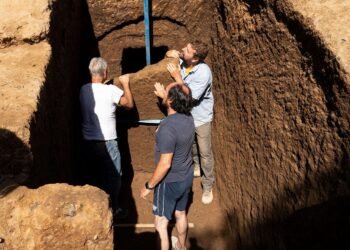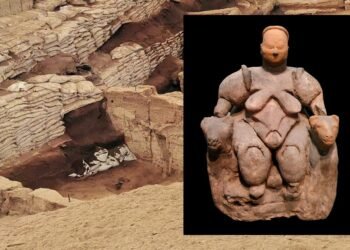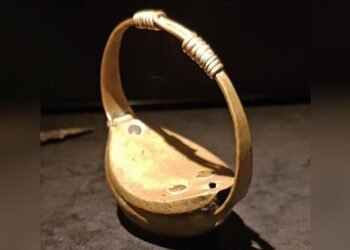Archaeologists from Oxford Archaeology, conducting excavations as part of the Benson Relief Road construction in Oxfordshire, England, have unearthed a remarkably well-preserved Bronze Age wooden well.

The excavation, undertaken by Oxford Archaeology on behalf of the Oxfordshire County Council, aimed to ensure that any archaeological finds are meticulously recorded and preserved.
Senior Project Manager at Oxford Archaeology, John Boothroyd, explained the initial stages of the discovery: “When investigating what appeared to be a standard pit for the site, the archaeological team started exposing the remains of a preserved wooden post driven vertically into the ground.”
Further investigation uncovered that these posts formed part of a wattle structure lining the edge of the well. The preservation of such wooden structures from this period is rare, owing to the waterlogged conditions of the soil, which have protected the remains over time.

Despite the challenging conditions, the archaeological team successfully exposed and fully recorded the well. Boothroyd noted, “The specialist soil samples collected will also help establish what the surrounding landscape would have been like, and the intensity to which it was settled when the well was actively being used.”
Councillor Judy Roberts, representing Oxfordshire County Council said: “This find gives fantastic insight into the area’s past land use.” She suggested that the well may have served agricultural irrigation needs for nearby settlements. Roberts added: “They help us identify and understand past residents of the area and record them for future generations.”
The excavation also yielded various artifacts, including pieces of struck flint, animal bone, and pottery fragments used for storage and waste. These findings, along with the well’s wood samples, have been entrusted to the Oxfordshire Museum Service for further analysis and preservation. The well’s wooden lining was carefully dismantled by experts for removal, with a sample sent for detailed analysis to identify the wood type and possible evidence of tools used in its construction.
The Oxfordshire County Council announced that the recovered artifacts, including the wood, will be housed at the Oxfordshire Museum Service. A comprehensive report detailing the excavation findings is anticipated to be released in the near future.
























